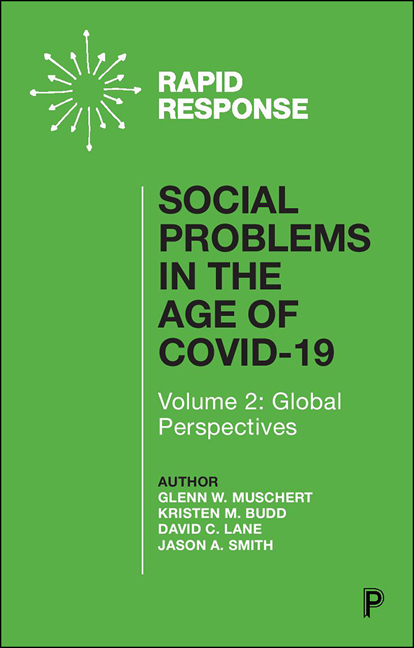Book contents
- Frontmatter
- Contents
- Acknowledgments
- Presidential Welcome
- Editorial Introduction
- 1 Isolation, Economic Desperation, and Exploitation: Human Trafficking and the COVID-19 Crisis
- 2 Uncertainty and Disruption in the Transition to Adulthood During COVID-19
- 3 Disability Rights and Healthcare Rationing during COVID-19
- 4 Social-Distancing the Settler-State: Indigenous Peoples in the Age of COVID-19
- 5 The Pandemic and the Invisible Poor of the Global South: Slum Dwellers in Mumbai, India and Dhaka, Bangladesh
- 6 The Human Right to Water and Sanitation in the Age of COVID-19
- 7 Pandemic Perils of Migrant Workers: Inequalities Intensified
- 8 Food Insecurity and COVID-19
- 9 Protecting Refugee Health and Human Rights in the Context of the COVID-19 Pandemic: Challenges and Pathways to Justice
- 10 COVID-19 Requires an Intersectional Feminist Policy Response
- End Matter
- Afterword
- Index
8 - Food Insecurity and COVID-19
Published online by Cambridge University Press: 23 March 2021
- Frontmatter
- Contents
- Acknowledgments
- Presidential Welcome
- Editorial Introduction
- 1 Isolation, Economic Desperation, and Exploitation: Human Trafficking and the COVID-19 Crisis
- 2 Uncertainty and Disruption in the Transition to Adulthood During COVID-19
- 3 Disability Rights and Healthcare Rationing during COVID-19
- 4 Social-Distancing the Settler-State: Indigenous Peoples in the Age of COVID-19
- 5 The Pandemic and the Invisible Poor of the Global South: Slum Dwellers in Mumbai, India and Dhaka, Bangladesh
- 6 The Human Right to Water and Sanitation in the Age of COVID-19
- 7 Pandemic Perils of Migrant Workers: Inequalities Intensified
- 8 Food Insecurity and COVID-19
- 9 Protecting Refugee Health and Human Rights in the Context of the COVID-19 Pandemic: Challenges and Pathways to Justice
- 10 COVID-19 Requires an Intersectional Feminist Policy Response
- End Matter
- Afterword
- Index
Summary
The Problem
The outbreak of the COVID-19 pandemic caused a significant increase in the number of people who experience food insecurity and hunger worldwide. Simultaneously, new solidarity alliances have emerged to bridge the gap between food destined to be wasted and the rising need. Hunger is lifethreatening. In 1948 the United Nations General Assembly first recognized the right to food as a universal human right. The current pandemic deepens the global hunger crisis, thereby jeopardizing much more than the right to food. The European Food Banks Federation, together with other institutions, reported in May 2020 that organizations such as food pantries and food banks will not be able to fight the hunger crisis caused by COVID-19 by themselves. Without immediate action, the United Nations emphasized that the pandemic will lead to a global food emergency.
Hunger and food insecurity are not new phenomena. From an individual to a global level, the problem of food insecurity covers a wide spectrum. It can range from: (a) seemingly insignificant family food practices, such as the “Coolest Mom at School” plastic sandwich and fruit cutters (as advertised and sold on Amazon US for $24 per set) to (b) the fact that according to the United Nations 25,000 humans, of whom more than 10,000 are children, die from hunger and hungerrelated effects each day. In June 2020, 822 million people were undernourished worldwide, 60 percent of whom were female. Due to the consequences of the current pandemic on food chains, the World Food Programme estimates that by December 2020 an additional 130 million humans are expected to be exposed to famine. Hunger is pandemic.
Even before the outbreak of COVID-19, one-third of all food produced worldwide was lost or wasted. Annually this amounts to 1.3 billion tons of food. This amount could feed every hungry person in this world. If wasted food was a country, it would be the third principal producer of carbon dioxide worldwide. Food waste increased dramatically during COVID-19. This intensifies the global climate crisis.
On an individual level, the food crisis caused by the pandemic can heighten the awareness of questions such as: What happens to the cut off bread crusts created by sandwich cutters? What are the family food practices that demonstrate wastefulness? During a health crisis such as the COVID-19 pandemic, humans need to adapt their habits.
- Type
- Chapter
- Information
- Social Problems in the Age of COVID-19 Vol 2Volume 2: Global Perspectives, pp. 87 - 98Publisher: Bristol University PressPrint publication year: 2020



